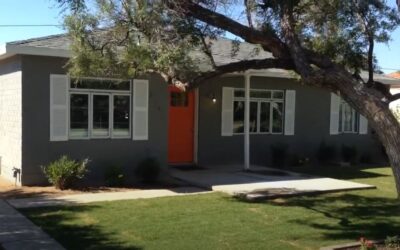Co-authored by Patrick Young
If you are rehabbing a property for either the Fix/Flip or Buy/Hold model of real estate investing and you’d like it to widen your pool of buyers or renters, keep reading. Here, we will take a look at a few features that should be included in a home for someone with limited mobility or disability and offer advice for real estate investors on how to make their properties appeal to buyers with special accessibility needs.
Homes built with accessibility in mind should have these minimum fundamentals in their design:
- Doorways that are at least 32 inches wide to accommodate wheelchairs
- 36 inches of space around doorways
- A wheelchair-accessible ramp
- Doorknobs switched to pulls
- Handrails for stairs or ramps within the home.
While the Americans with Disabilities Act legally applies only to public and commercial spaces, the ADA guidelines can be used to designing amazing, accessible, private residences as well. There is a whole laundry list of hidden features you might want to incorporate into your next rehab project to make it super appealing to someone with mobility or other physical issues.
The Features of an ADA Accessible Residence
According to the CDC the percent of adults aged 18 and over with any physical functioning difficulty is 16.3% and would benefit from an ADA accessible residence. In addition to being your potential buyers or tenants, how many folks have periodic guests that would benefit from these design features? Do you really want to limit your potential customer base by not including at least some features that could open up more options to you – and to them?
The main question to pose in any room is: “How can someone in a wheelchair, with limited vision or generally limited mobility, move about this room and access what is needed on a daily basis?”
The answer to that question might not be obvious to those people who don’t deal with such concerns on a daily basis. To provide some insight, here are some features that you can build into your home to make it more accessible and provide you with more buyers or tenants for your property.
Ramps and Slopes
Ramps might be the first thing you think of when you think of designing a home for people with limited mobility. Not only are they necessary for wheelchairs but they’re ultra-handy for people who use walkers as well.
A couple of things to keep in mind is that ramps should be at least 36 inches wide so that wheelchairs can easily and comfortably fit in between the handrails or walls on either side of the ramp.
It’s also recommended that for every inch of vertical rise, there’s a foot of horizontal distance. If a ramp rises 7 inches, for example, it should also be 7 feet long to provide a nice, gentle slope.
Finally, it might be worth considering providing a flat landing on long ramps where someone in a wheelchair can stop if they need to.

Parking & Loading Zones
Did you know that some vehicles that are specially made for people with disabilities are sometimes taller than your average people-carrier? Because of that reason, it might be a good idea to have garage doors that are 98 inches tall or more (most standard garages are 84 inches tall).
Getting into and out of a vehicle also requires a bit of maneuvering. Making sure there’s ample space in the parking lot or garage to approach the side of the vehicle with either a walker or a wheelchair is key. Not only should there be room for those mobility aids but there should also be room for a hinged door to swing wide open in addition to the mobility equipment plus even more room for an extra person to stand.
Paddle Handles
Door knobs can be difficult to use for many people, especially those with severe arthritis or other limb-inhibiting conditions. Paddle-style handles are easy to operate and come in all sorts of styles and finishes to blend with any decor.

Hallways & Doors
The doorways and halls should be at least 32 inches wide. This is the same logic that goes for the 36-inch-wide ramp; walkers and wheelchairs take up a not-insignificant amount of room.
Hallways and doors should also be clear of thresholds, bumps, or other obstructions more than 1/4 of an inch tall. It might not seem like a lot but it doesn’t take much for the small wheels of many walkers to be stopped dead in their tracks by a small rise in the floor’s level and wheelchairs can fall over backward when trying to roll over a significantly sized threshold.
Just like in the parking and loading example, doors swing open and take up space. There should be at least 18 inches of clear space in the direction the door swings open so that people with walkers and wheelchairs can approach the door and pull it open.
Finally, keep the handles no higher than 48 inches up the door so that someone in a seated position can still reach it.
Bathrooms
Bathrooms have a lot going on in them and there are many features that could add to their overall usability for people with disabilities or mobility issues.
Having a bathtub with non-slip flooring is crucial, and, fortunately, this is an easy post-purchase modification.
Each toilet should have a horizontal grab bar on the adjacent wall at least 40″ long and between 33″ and 36″ above the floor for stabilization and assistance during transfer from a wheelchair.
The toilet seat should be between 17″ and 19″ inches above the floor. Again, this is not only a nice feature to have when considering transferring from the toilet to a wheelchair, but even people who don’t struggle with mobility will find this to be a more comfortable setup.
The sink should have at least 29″ of clearance under the front edge to allow wheelchair users to pull under the sink and use the faucet. Think of sitting at a table. We sit with our legs comfortably UNDER the table so our food is close to your chest. The alternative would be something like a coffee-table where you’d have to uncomfortably bend and stretch to reach your food. No good.
Is there clear floor space of at least 30″ by 48″ in front of a sink to allow forward approach? If not, is there a way you can create one?
Is there a shower spray unit with a hose that is at least 60″ long and that can be used both as a fixed shower head and as a handheld shower? I don’t know if you’ve ever lived at a place that has this feature, but showerheads that are attached to hoses are convenient and awesome. Everyone will enjoy this.
There are additional items to consider when thinking about people who use wheelchairs or are unable to stand in a tub. They include firmly affixed tub seats, doors that swing out so someone doesn’t have to climb into the tub, and faucet controls that are easily reachable from the tub seat.

Bedrooms
There should be at least a 36″-wide route on each side of the bed and at the foot of the bed to allow people who use wheelchairs to transfer onto the bed from either side.
The rods and shelves in the closet should be within 54″ of the floor for side approach or 48″ of the floor for forward approach for people in wheelchairs.
How an ADA Accessible Home Benefits Real Estate Investors
As a real estate investor, you want your properties to appeal to people of all ages and abilities. Fortunately, it is not that difficult or necessarily cost-prohibitive to make this happen. When you begin your rehab scope of work, do so while keeping the needs of people with disabilities in mind.
An example of a buyer that isn’t limited in their mobility but might still love all the additional features are parents with strollers. They can benefit from the same adaptations as a wheelchair user. Not only that, but wide hallways, open door design, large garages, a lack of trip hazards, and pull-style handles are just convenient and comfortable for everybody.
By focusing on upgrades that make your home more accessible, you will provide more of a universal design, which is a great way to increase the property’s value. Because universal design allows for attractive amenities that are usable by a broad range of people, your home will be more in-demand when it’s time to sell. You will attract more buyers, and can likely command a higher selling price while enjoying a faster turnaround.
Where to Start Making a Property More Accessible
For renovations, start with those that will have the most impact. One of these might be to add lighting in dark areas, such as the hallway or stairs, and don’t be afraid to add overhead and task lighting to illuminate other dim areas.
Next up, it’s time to replace door and cabinet hardware. Ditch traditional knobs and instead utilize pull-style handles in the kitchen and bathroom.
You have many choices, and the KitchenSurfing blog showcases several stylish options that will easily go with traditional or modern decor. Lever-style door handles will also appeal to more buyers.
One of your biggest expenses when renovating a home with accessibility in mind is flooring. The good news here is that hard surfaces are typically best, and those also happen to be some of the most in-demand for all buyers. Disability-friendly flooring includes hardwood, tile, and laminate planks.







